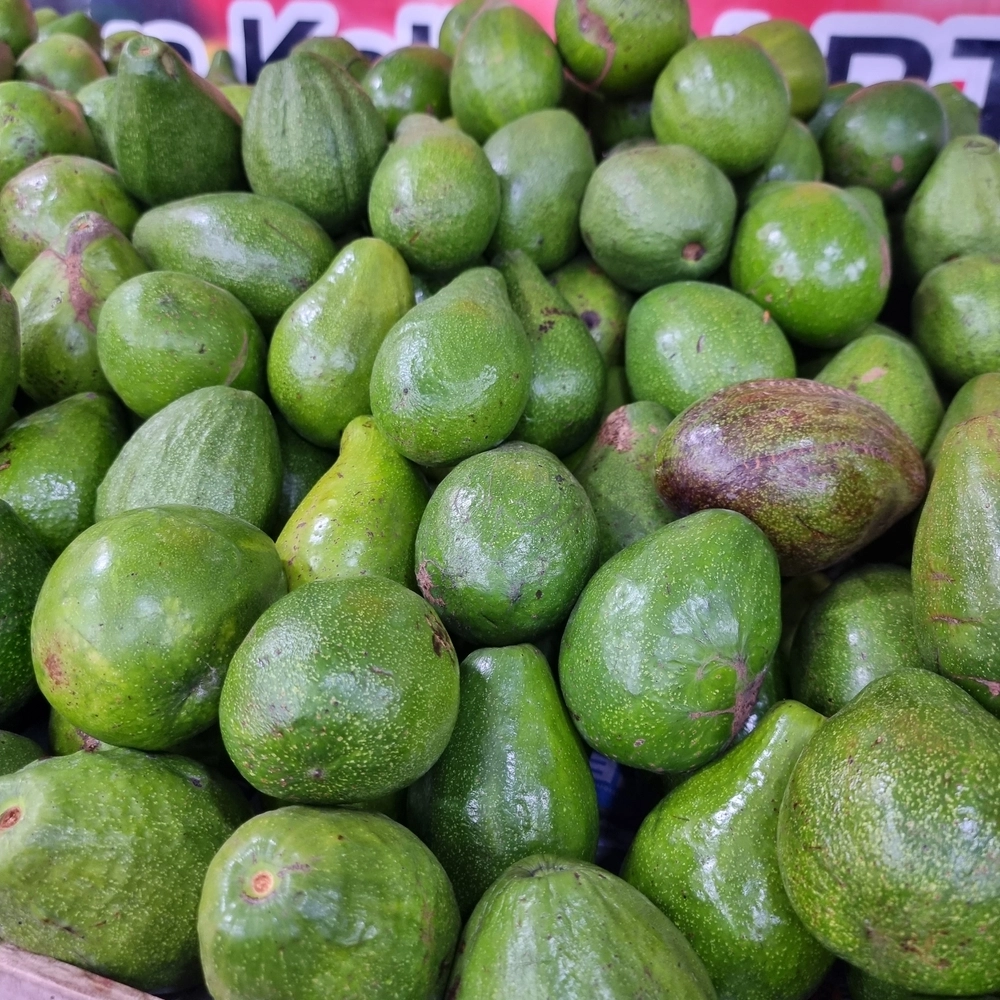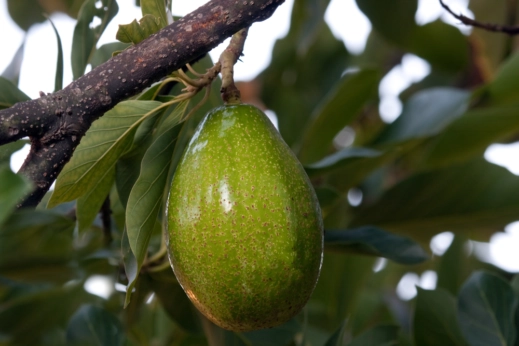Trade restrictions between several Mexican states and the US mean many of the best ingredients don’t make their way across the border.

When I saw the local avocados in the Mexican state of Yucatan, a hot, humid region located in the south of the country, I didn’t think they were avocados. Some were the size of small melons, others the size of a large mango, three to five times the size of a Hass avocado. Perhaps these were another exotic Mexican fruit that coincidentally had the scaly green skin of an avocado. I asked the woman selling them at the market in Mérida (the capital city of Yucatán state), and she confirmed to me: “Sí, aguacate.”
At the grocery store, this variety was simply labeled as aguacate local (local avocado), but it is commonly called aguacate mantequilla (butter avocado). It was significantly cheaper than the Hass avocados being sold; one local avocado that I purchased cost $25 pesos, which is roughly $1.25.
I was enthralled. Why wasn’t anyone else going crazy about these avocados? I could easily see one of these being sold in the U.S. for $15—and people would buy it. We go crazy for avocados in the United States; consumers here are happy to spend big bucks on avocado toast, guacamole, avocado sushi rolls and more.
However, we can’t get these avocados in the United States due to trade restrictions set forth more than 25 years ago. Since 1997, Michoacán, located in west-central Mexico touching the Pacific Ocean, has been the only Mexican state approved to export avocados to the United States.
Why is this so? Growers in Michoacán are part of a certification program in which they are able to confirm that their fruit is free from certain pests such as avocado seed weevils or fruit flies, and their orchards are also subject to compliance checks by inspectors from the USDA’s Animal and Plant Health Inspection Service (APHIS). Lucero Hernández, a public affairs specialist from APHIS, explained that its system “uses multiple, overlapping measures that work together to adequately mitigate pest risk on imported commodities. For this commodity, some of these measures include trapping and surveying for pests, orchard sanitation, cleaning of the fruit at packing houses and inspections.” Avocado shipments from Michoacán must also meet additional requirements, including orchard certification and registration, packinghouse certification and registration and US port-of-arrival phytosanitary inspection.
The USDA keeps the Agricultural Commodity Import Requirements (ACIR) database with information on global crops and commodities. If something is not listed or is listed as “inadmissible” in the ACIR, it is prohibited entry into the United States.

Photography by Shutterstock
Michoacán is certified through this program, and 80 percent of all avocados produced in this state, a value of $3.2 billion, are exported to the US. But most other Mexican states aren’t part of this program, so we don’t get to import their avocados—at least, not yet.
In 2021, news broke in the avocado industry when Jalisco, the state directly north of Michoacán, was the second Mexican state to be approved to export avocados to the US after reaching a similar agreement. There are 31 states in Mexico, and Nayarit and Mexico State are currently being considered to be approved for avocado export as well—but not yet the home of the giant butter avocados, Yucatán state.
Mexico is the United States’s largest agricultural trading partner. Thanks to Mexico, the US can have crops, such as pineapple and papaya, that don’t thrive in our region. Berries, lettuce, tomatoes and cucumbers can certainly be grown here, but in colder seasons, these items are often imported from Mexico, with the US bringing in $38.7 billion worth of agricultural goods in 2021.
But even with all of that produce coming into the country each year, American consumers are missing out on more than just avocados. Juana Torres Zaragoza, a Mexican home cook, was born in Michoacán and currently lives in Mexico City. She has spent time in California, and she sees considerable differences with particular ingredients. Zaragoza noticed that, “chiles have many different names and flavors; also they are spicier in Mexico, and there is more variety. There is also no corn for pozole or huitlacoche. To cook mole, there is only one option for mole in paste form, which is of low quality, forcing you to use chiles to make a better mole yourself.”
As a result, this also influences the final flavor. “Since the chiles are different, the food has a different seasoning, and there are fewer options for seasoning,” says Zaragoza.
Magdalena Morales is a culinary school graduate who was born and raised in the US, spending a majority of her life in Illinois. She would travel to Guadalajara and Pajacuarán every summer as a child, and she always loved cooking Mexican cuisine. “I have modified a few recipes due to just wanting to have that taste of home,” she says. “Once I moved away from home and was able to go to Mexico less, I noticed some of the chiles I grew up using were becoming hard to find. While I could still find some of those staple items I loved, they seemed to lack quality. I started to substitute for what I did have available,and, for the most part, not much changed. But even the subtle changes differed from my memories of my favorite dishes.”
This had an impact on what she chose to cook. “I think eventually, I started cooking less Mexican food since I could not find the ingredients I was looking for.”
Professional Mexican chefs working in the United States have an advantage over home cooks—they are often able to connect directly with producers in Mexico or request special orders through produce and food vendors. Chef Iliana de la Vega is from Mexico City and now lives in Austin, Texas, where she owns and operates El Naranjo. She sources hard-to-find items directly from Mexico. “Fresh huitlacoche, I get that from Mexico. It’s not available in stores, it’s more for restaurants.”
But if specialty ingredients are harder to find, some chefs have opted for substitutes, with promising results. José Cepeda, executive chef at Quixote in San Diego, says that finding substitutions can become “essential.” Instead of some specialty chiles, Cepeda uses similar flavors such as chile cascabel, chile costeño or chile puya. He does not have access to green ayocote beans, but he substituted this with edamame beans and reported that the result was actually really good. Instead of the famous Oaxacan/Puebla goat meat used for mole de caderas, he uses organic, grass-fed, high-quality lamb meat.
“Despite challenges, I try to find the bright side of using alternative ingredients. I find that using local ingredients mixed with traditional touches sometimes creates something new and cool for Quixote customers. I think this is a great way to preserve the tradition and create a cultural impact,” says Cepeda.
In October 2023, a group of 20 producers from Tamaulipas joined a trade mission and export seminar in McAllen, Texas, with the intention of finding new markets for their products, including chili peppers, tomatoes, sesame oil, citrus, aloe, mezcal, garlic and honey. The producers received training on the processes for exporting their products to the United States, and they also participated in meetings with potential buyers.
Chef de la Vega also sees this increase of new trade channels firsthand. “We are getting more and more Mexican ingredients every day. For the restaurant, 90 percent to 95 percent of the ingredients we use are Mexican.”
They grow these in Florida also
If those avocados taste anything like the similar looking ones I had in Florida they can keep them. Haas avocados taste much better.
In 1997 my son & I stayed in Playa del Carmen for a week. Our highlight of our trip was bringing fresh avocados back to our hotel room. We sliced or mashed them every day & ate them on fresh bread for breakfast daily! I still think of those delicious avocados; wish I could obtain them here!!
Lol…this is the typical avocado sold in Florida especially south FL ..staple in the carrebiean diet. Known locally as the aguacate Criollo. Marketed in English as avo light, less fat
Butter avocado is everywhere in Hawaii!
I am tired to buy the avocados here in the United States you buy 3 and throw 2 away of every time I buy them plus they were so expensive you can get avocados where I live in Mexico part-time in the Mexicali area Basically for about 40 to 50 cents each and they are beautiful Never have to throw one away I will not buy avocados in the grocery store here at all anymore
Those new avocados that we are getting now from republic dominican for the past few months are not good at all.
I live in Brazil and we have here a huge variety of avocados, including ‘abacate manteiga’‼️ They are wonderful – the American consumers are getting screwed. Hope that common sense will prevail, and strong Mex lobby, that keeps this wonderful variety out – be overcome. Also – the economic/political interests interfere in the Aricultural decision making. Let’s change that‼️ let’s get this Avocado into the States for American consumers to enjoy…..
Great
I grew a variant of the Fuerte in Valley Center which had a bacon flavor. NAFTA and the diseases from Mexico ended that. Many cartels are deeply involved in agriculture sent to the U.S. Also, soft-skinned varieties ripen more quickly and are difficult to ship. I sold mine quickly, to Vegan customers.